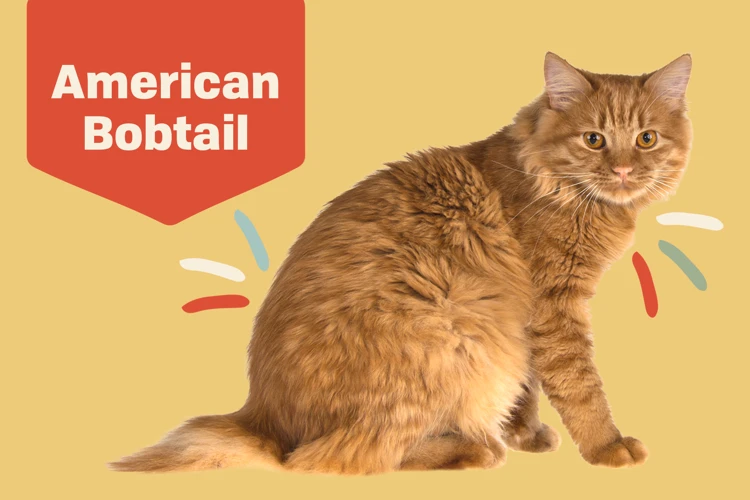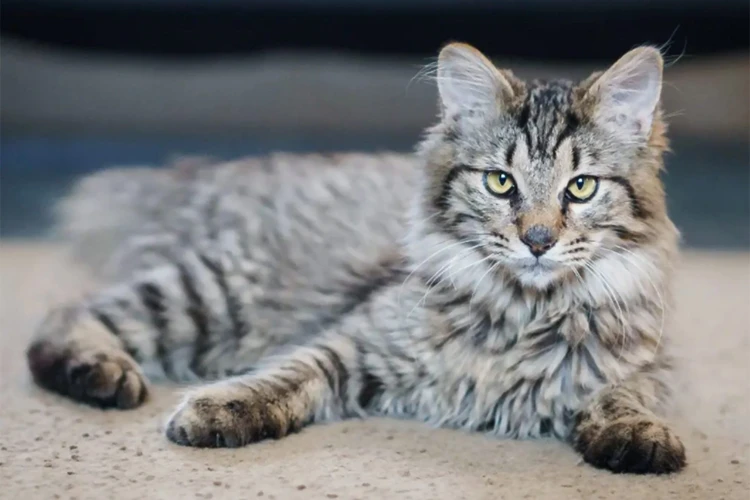One of the most challenging aspects of being a cat owner is training them. Unlike dogs, cats are known for their independence and can be stubborn when it comes to obeying commands. However, with the right approach, training your American Bobtail can be a rewarding experience for both you and your feline companion. In this article, we will explore the benefits of reward-based training and provide practical tips, dos and don’ts, and FAQs on this effective training approach. Whether you are a seasoned cat owner or a newbie, read on for useful insights on how to successfully train your American Bobtail.
What is reward-based training and why is it effective?

Reward-based training is a positive and effective way to train your American Bobtail. This training method involves encouraging good behavior by providing rewards and incentives, rather than using punishment or negative reinforcement. By using rewards to reinforce good behavior, you can help your American Bobtail develop positive habits and reduce unwanted behavior. In the following sections, we will explore the science behind reward-based training and the practical tips for training your American Bobtail effectively. If you’re interested in learning more about clicker training, check out our article on clicker training for American Bobtails.
The science behind reward-based training
When it comes to training American Bobtails, using reward-based methods has been proven to be very effective. The science behind reward-based training is rooted in the idea that positive reinforcement encourages the repetition of desired behaviors. Essentially, when a cat performs a behavior and is rewarded for it, their brain releases dopamine, a neurotransmitter associated with feelings of pleasure and satisfaction. Over time, the cat will begin to associate the behavior with the positive feeling and is more likely to repeat the behavior in the future.
Studies have shown that reward-based training is more effective than punishment-based training when it comes to long-term behavior modification. When a cat is punished for an unwanted behavior, they may learn to stop the behavior temporarily to avoid the punishment, but they don’t necessarily learn what they should do instead. On the other hand, when a cat is rewarded for a desired behavior, they learn what they should be doing and are more likely to repeat the behavior.
Another interesting aspect of the science behind reward-based training is that it goes beyond just the targeted behavior. Studies have shown that cats that are trained using positive reinforcement methods are more confident, easier to handle, and have better overall social skills than those trained with punishment.
Understanding the scientific basis behind reward-based training can help American Bobtail owners better appreciate the benefits of this effective training method. Not only does it encourage the repetition of desired behaviors and lead to long-term behavior modification, but it also helps develop positive traits in cats.
The benefits of positive reinforcement
Positive reinforcement is an essential tool in training American Bobtails as it is a proven and effective method that strengthens the bond and trust between pet parent and pet. The benefits of positive reinforcement go beyond training, and it impacts the overall well-being of the cat.
The following table outlines some of the major benefits of positive reinforcement in training American Bobtails:
| Benefits of Positive Reinforcement |
|---|
| Encourages desired behavior: Positive reinforcement encourages the desired behavior and tricks the cat’s brain into associating the behavior with a positive reward. This approach is a better alternative to punishment that discourages bad behavior without providing an alternative solution. |
| Strengthens the bond: When pets receive treats and praise, they feel valued and appreciated, which strengthens the bond with their humans. This deeper bond improves communication and trust, making it easier for them to understand commands and for pet parents to read their body language. |
| Boosts confidence and reduces anxiety: Using rewards can boost the feline’s confidence, reduce anxiety, and make them feel more secure. This approach is particularly helpful for cats that have undergone previous trauma, cats with anxiety or fears, or adult cats that are adapting to new environments. |
| Encourages learning: Positive reinforcement creates a more conducive learning environment, making cats more receptive to commands and training. When there’s training involvement, cat’s brains tend to be more stimulated preventing them from getting bored and engaging in unwanted bad behavior. |
| Produces Long-lasting behavior changes: Positive reinforcement usually results in longer-lasting behavior changes making it ideal for the American Bobtail breed, who are known to form a strong bond with their owner. |
Positive reinforcement-based training helps create a happy, harmonious home for both the pet and pet parents. It creates a gentle and nurturing environment that the American Bobtail thrives in. By using rewards and positive reinforcement, pet parents encourage good behavior and foster a happy and healthy relationship with their feline friends.
Also, remember that a happy and healthy American Bobtail is more responsive to training. Check out the article “American Bobtail Cat Body Language” to know what to expect from your feline friend. If you encounter some challenges during training, read the article “Common Behavior Problems in American Bobtails” for helpful tips.
Practical Tips for Reward-Based Training of American Bobtails

Feline enthusiasts who are up for the challenge of training an American Bobtail will need a reliable and humane approach. For those who want their furry buddies to learn desirable behaviors without any negative consequences, reward-based training is a popular choice. This method of training effectively teaches a cat to repeat good behavior based on the positive experiences it gets from following a specific command. Below are some practical tips that can make reward-based training of American Bobtails a fun and fruitful activity for both you and your pet.
Choosing the right rewards and timing
One of the most crucial factors in reward-based training is choosing the right rewards and timing. In order to be effective, the reward must be something that the cat enjoys and is motivated by. This can vary from cat to cat, but some common examples of rewards include treats, toys, and praise. It’s important to experiment with different types of rewards to see what your American Bobtail responds to best.
The timing of the reward is also essential in reward-based training. The reward should be given immediately after the desired behavior has been displayed. This reinforces the connection between the behavior and the reward in the cat’s mind. Delaying the reward can cause confusion and make it more difficult for the cat to understand what they are being rewarded for.
Additionally, rewards should be used sparingly and only for desirable behavior. Over-rewarding can lead to the cat losing motivation and becoming desensitized to the reward. On the other hand, not rewarding enough can reduce the effectiveness of the training. It’s all about finding the right balance.
Using a clicker can also be helpful in timing the reward correctly. A clicker is a small device that makes a clicking noise when pressed. The noise acts as a signal to the cat that they have done the right thing and a reward is coming.
Choosing the right rewards and timing is a critical element of reward-based training for American Bobtails. By using rewards that your cat enjoys and timing them correctly, you can effectively and positively reinforce desirable behavior. Remember to use rewards sparingly and experiment with different types of rewards to find what works best for your cat.
Establishing clear communication and consistent commands
One of the key aspects of reward-based training for American Bobtails is establishing clear communication and consistent commands. This is crucial for ensuring that your cat understands what is expected of them and what behavior will be rewarded.
Use simple, consistent commands: When training your American Bobtail, it’s important to use simple, consistent commands that are easy for them to understand. For example, if you want your cat to sit, use the word “sit” consistently every time you give the command. This will help your cat associate the command with the action you want them to perform.
Use body language: Body language is another important aspect of clear communication when training your American Bobtail. Using consistent body language along with verbal commands can help reinforce the message you are trying to convey to your cat. For example, when teaching your cat to sit, use a hand signal to reinforce the verbal command.
Practice regularly: Practice makes perfect when it comes to training your American Bobtail. Make sure to set aside regular training sessions each day and stick to them consistently. This will help your cat develop good habits and strengthen the bond between you and your pet.
Avoid confusion: It’s essential to avoid confusion when training your American Bobtail. Make sure not to use the same command for multiple actions, as this can create confusion and make it harder for your cat to understand what you want them to do. Also, avoid using negative commands and instead focus on rewarding positive behavior.
By following these tips, you can establish clear communication and consistent commands when training your American Bobtail, resulting in a more effective and rewarding training experience for both you and your pet. For more information on basic training commands for American Bobtails, check out our guide on Basic Commands for American Bobtails.
Dealing with unwanted behavior and avoiding punishment
It’s important to remember that while reward-based training is a highly effective method, it might not always go according to plan. American Bobtails, like any other breed of cat, can exhibit unwanted behavior during training such as scratching, biting, or simply ignoring commands.
Dealing with unwanted behavior
When dealing with unwanted behavior, it’s important to stay calm and not resort to punishment. Scolding or hitting your cat will only make them fearful and less receptive to training. Instead, try to redirect their attention by using a toy or a treat to entice them to focus on something else. It’s also important to try and identify the root cause of the behavior. For example, if your cat is scratching at the furniture, it might be because they are bored or not getting enough exercise. Try to address the root cause of the behavior in addition to correcting the behavior itself.
Avoiding punishment
Punishing your cat for unwanted behavior may seem like a quick fix, but it can ultimately be counterproductive. Negative reinforcement can cause your cat to become fearful and avoidant rather than responsive to your commands. Avoid shouting, hitting, or using other physical means to correct your cat’s behavior.
Instead, try to focus on the positive. When your cat exhibits the desired behavior, reward them with praise and treats. This will encourage them to continue following your commands and decrease the likelihood of unwanted behavior.
Example of unwanted behavior
For example, if your American Bobtail is exhibiting scratching behavior, don’t yell at them or punish them. Instead, provide them with a scratching post and reward them when they use it.
Remember, patience is key when it comes to training your American Bobtail. If you are facing difficulties, try to identify the root cause of the behavior and work on addressing it. Negative reinforcement will only cause more harm than good in the long run.
If you want to know more about training your American Bobtail or how to introduce them to kitten socialization or leash training, check out our articles on kitten socialization and leash training.
Praising and reinforcing good behavior effectively
One essential aspect of reward-based training for American Bobtails is the effective use of praise and reinforcement. It’s important to make sure that your cat understands which behaviors you want them to continue exhibiting. Here are some practical tips for praising and reinforcing good behavior:
- Be clear and specific: When praising your American Bobtail, use a clear and specific phrase such as “good job” or “well done” to let them know exactly what they did correctly. This helps them to understand which behaviors are desirable.
- Offer immediate rewards: Try to offer your cat a reward right after they exhibit good behavior to reinforce that it is something you want them to continue doing. This immediate feedback reinforces the connection between the behavior and the reward.
- Give treats: Treats can be highly motivating for American Bobtails. Use a small, bite-sized treat that your cat loves and give it to them as soon as they exhibit the desired behavior. Make sure that you do not offer the treat in advance, as it may confuse your cat and undermine the effectiveness of the reward.
- Use positive body language: While giving praise, make sure to use positive body language, such as a smile, a nod, or a pat on the back. These actions help to reinforce the positivity of the interaction and encourage your cat to continue exhibiting good behavior.
- Do not use punishment: Avoid using punishments in reward-based training. Instead, focus on rewarding good behavior. Punishments can be confusing for your cat and may interfere with the training process.
By using positive reinforcement techniques and these practical tips, you can effectively praise and reinforce good behavior in your American Bobtail. This helps to create a positive training environment and encourages your cat to continue learning and growing.
The Dos and Don’ts of Reward-Based Training for American Bobtails

Reward-based training is an effective and humane way to teach American Bobtails proper behavior and obedience. However, it is important to follow certain guidelines in order to maximize the benefits of this training method, while avoiding common mistakes that can hinder progress. In this section, we will discuss the best practices and pitfalls to avoid when implementing reward-based training for American Bobtails. By following these dos and don’ts, you will be able to ensure that your furry friend is on the path to becoming a well-trained and happy cat companion.
Things to keep in mind when using rewards
When it comes to reward-based training for American Bobtails, there are some important things to keep in mind to ensure that the training is effective and your cat learns the desired behavior. Here are some tips:
- Choose rewards that your cat enjoys: As mentioned before, rewards are a crucial part of positive reinforcement. Make sure you choose rewards that your American Bobtail loves, such as their favorite treats or toys.
- Timing is key: Rewards should be given immediately after the desired behavior is exhibited. This helps your cat understand which behavior will lead to the reward.
- Consistency is crucial: Be consistent in the rewards you give and the commands you use. This helps your American Bobtail understand what you expect of them.
- Keep the rewards small: You want to keep your cat motivated, but not raise their expectations too high. Small rewards are effective, and will keep your cat motivated to learn.
- Avoid rewards for bad behavior: Only reward your American Bobtail for exhibiting the desired behavior. This will help to reinforce good habits and quickly discourage bad behavior.
- Never use punishment: Remember that reward-based training revolves around positive reinforcement, so never use punishment to train your cat. Punishment can damage the bond between you and your cat, and lead to undesirable behavior.
By keeping these things in mind, you can ensure that your reward-based training for your American Bobtail is effective and enjoyable for both you and your cat. For more information on the breed, check out our American Bobtail Introduction article.
Common mistakes to avoid
When practicing reward-based training with your American Bobtail, it’s important to be mindful of common mistakes that can hinder the effectiveness of the training. Here are some of the most common mistakes to avoid:
- Using punishment instead of rewards: Punishment and negative reinforcement can cause fear and anxiety in your cat, leading to behavioral issues.
- Lack of consistency: Inconsistency in commands, rewards, and communication can confuse your cat and hinder progress in their training.
- Timing issues: Rewards should be given immediately after desired behavior is exhibited. Delayed rewards can confuse your cat and cause frustration.
- Not varying rewards: Offering the same reward repeatedly can reduce its value and make it less effective. Varying rewards can keep your cat engaged and motivated to learn.
- Setting unrealistic expectations: Every cat has their own unique personality and learning ability. Setting unrealistic expectations and pushing your cat too hard can cause frustration and discourage learning.
- Ignoring unwanted behavior: Ignoring unwanted behavior can reinforce it and make it more difficult to correct in the future.
By avoiding these common mistakes, you can ensure that your reward-based training with your American Bobtail is effective and positive. Remember to be patient and consistent, and always prioritize your cat’s well-being and comfort during training sessions.
How to adjust training for different ages, temperaments, and backgrounds
When it comes to training American Bobtails using rewards, it’s important to consider their age, temperament, and background. Different cats have different needs, and tailoring your approach to their individual needs will yield better results. Here are some tips on how to adjust training for different American Bobtails:
| Age | Temperament | Background | Training Tips |
| Kittens (2-6 months) | Curious, playful, energetic | No previous training | Start with basic commands such as “sit” and “come.” Keep training sessions short and fun, and use lots of praise to motivate the kitten. Use simple, high-value rewards such as small pieces of tuna or chicken. |
| Adults (6 months-2 years) | Moderately active, may be more independent | Limited or inconsistent previous training | Focus on more advanced commands such as “stay” and “heel.” Use a mix of high-value and low-value rewards. Be patient but firm, and avoid punishing unwanted behavior. |
| Seniors (2+ years) | Laid-back, may be less active | Varied training experiences | Stick to simple commands and shorter training sessions. Use high-value rewards such as cooked chicken or tuna. Be aware of any physical limitations and adjust training accordingly. |
It’s important to also consider your cat’s temperament and background. Some American Bobtails may be more anxious or fearful due to past experiences, while others may be more stubborn or independent. Here are some tips for adjusting training based on temperament and background:
– Anxious or fearful cats may require more patience and frequent rewards. Use calming techniques such as gentle stroking or a soothing voice to help them relax.
– Stubborn or independent cats may require more consistent training and clear commands. Use high-value rewards to motivate them and be firm but positive.
– Cats with limited or inconsistent training may require more frequent rewards and repetition. Be patient and avoid punishment, as this can reinforce negative behavior.
No matter your cat’s age, temperament, or background, reward-based training can be effective with patience, consistency, and a tailored approach.
FAQs on Reward-Based Training for American Bobtails
As with any training method, there are often questions and uncertainties that arise. Here are a few common questions about reward-based training for American Bobtails, along with helpful answers and tips. Whether you’re a new or seasoned cat owner, these FAQs will provide guidance on how to effectively use reward-based training to teach your furry friend new behaviors and reinforce positive habits.
What if my cat doesn’t respond to rewards?
It can be frustrating when you’re trying to use reward-based training with your American Bobtail, but they don’t seem to be responding positively to the rewards you’re using. Here are some tips to help get your cat engaged and motivated during reward-based training:
- Try different rewards: Not all cats will respond to the same type of reward. Experiment with different treats, toys, and praise to see what your cat prefers.
- Change up the training: Your cat may be getting bored or overwhelmed with the same training exercises. Try adding some variety to the training routine to keep your cat engaged and interested.
- Adjust expectations: It’s possible that you’re expecting too much too soon from your cat. Break down the training into smaller steps and celebrate each small improvement your cat makes.
- Check for distractions: If your cat is in a busy or noisy environment, they may have trouble focusing on the training. Choose a quiet, distraction-free area for training sessions.
- Consult a professional: If you’re still having trouble, consider reaching out to a professional cat trainer or behaviorist for assistance.
Remember, every cat is unique and may respond differently to reward-based training. Be patient and persistent, and you’ll likely see progress over time.
Can I use different types of rewards?
When it comes to reward-based training for American Bobtails, it’s essential to choose the right rewards, but can you use different types of rewards?
The answer is yes! In fact, using a variety of rewards can help keep your cat engaged and motivated during training sessions. Here are some different types of rewards you can use:
- Treats: One of the most common types of rewards is food treats. You can use commercial cat treats or small pieces of your cat’s favorite foods, like chicken or tuna. Just be sure to use treats that are safe for cats and don’t overdo it with the portions.
- Toys: Some cats are more toy-motivated than food-motivated. You can use your cat’s favorite toys as rewards, or you can try new toys to see what he or she likes best.
- Praise: Don’t underestimate the power of praise! Many cats respond well to verbal praise, cuddles, and petting. Make sure to use a happy tone of voice and show affection to your cat after he or she behaves correctly.
- Playtime: For some cats, playtime is the ultimate reward. You can use playtime as a reward for good behavior, or you can integrate training exercises into playtime to make it more fun and stimulating.
Remember, different cats have different preferences, so it’s important to experiment with different types of rewards and find out what works best for your American Bobtail. Keep in mind that rewards should be used sparingly and appropriately, so your cat doesn’t become bored or lose motivation during training sessions.
Is it possible to use rewards for training older cats?
Older American Bobtail cats may not be as receptive to training as younger cats. However, it is still possible to use reward-based training techniques to modify the behavior of older cats.
Here are some tips for training older American Bobtail cats:
- Start with simple commands: Older cats may have a harder time learning complex commands, so it’s best to start with simple commands like ‘sit’ and ‘come’.
- Be patient: Older cats may take longer to learn and may require more patience and repetition before they understand what is expected of them.
- Use higher value treats: Because older cats may not have the same level of enthusiasm as younger cats, it’s important to use higher value treats that they really enjoy.
- Modify the training environment: Older cats may have difficulty with mobility, vision, or hearing, so it’s important to modify the training environment to accommodate for these issues. For example, if the cat has trouble seeing, use hand signals in addition to verbal commands.
- Be consistent: Older cats thrive on routine and consistency. It’s important to be consistent with the training schedule and use the same reward system each time.
- Avoid physical punishment: Physical punishment can be harmful to older cats, both physically and emotionally. It’s important to avoid any form of physical punishment and focus on the positive aspects of reward-based training techniques.
It may take more time and patience to train older American Bobtail cats using reward-based training methods, but it is possible with the right approach. By utilizing simple commands, high-value treats, accommodations for any physical issues, consistency, and avoiding punishment, older cats can learn new behaviors and tricks to enhance their relationship with their owner.
What are some examples of reward-based training for American Bobtails?
Training an American Bobtail with rewards can be a fun and interactive experience for both the cat and the owner. Here are some examples of reward-based training that can help you build a strong bond with your furry friend:
- Crate training: Reward your cat with treats and praise when they voluntarily enter their crate. Start by leaving the crate door open and placing a treat inside. Gradually move the treat further back until your cat is comfortable going inside the crate and staying there for longer periods of time.
- Clicker training: Clicker training involves using a clicking sound, followed by a treat, to mark the desired behavior. For example, if you want your cat to sit, say “sit” and as soon as they sit, click the clicker and give them a treat. Repeat this process until your cat associates the clicker sound with receiving a treat.
- Playing fetch: Yes, you can train your cat to play fetch using rewards! Start by tossing a small toy or ball and when your cat brings it back to you, give them a treat and praise. Repeat this activity, gradually increasing the distance you throw the toy.
- Teaching tricks: American Bobtails are intelligent cats, and they enjoy learning new things. You can use rewards to teach your cat how to high-five, spin in a circle, or even walk on a leash. Start by breaking down the trick into small steps and rewarding your cat for each successful attempt.
Remember, the key to success with reward-based training is to be patient, consistent, and have fun with your cat!
Conclusion
After reading this article on the benefits of reward-based training for American Bobtails, it’s clear that positive reinforcement is an efficient and humane way to train our furry friends. By using rewards to reinforce good behavior, we are fostering a positive and trusting relationship with our pets while also teaching them valuable skills.
It’s important to keep in mind the science behind reward-based training and the benefits of positive reinforcement, as these principles are key to successful training. Choosing the right rewards and establishing clear communication and consistent commands are practical tips that can make a significant difference when training our American Bobtails.
However, it’s equally important to be aware of the dos and don’ts of reward-based training, as well as how to adjust training for different ages, temperaments, and backgrounds. By avoiding common mistakes and adapting our approach to our cat’s individual needs, we can improve the effectiveness of our training and create a happier, healthier relationship with our pets.
To sum up, reward-based training is a humane and effective way to train American Bobtails while fostering positive relationships. By following the practical tips outlined in this article, avoiding common mistakes, and staying aware of our cat’s individual needs, we can make reward-based training a success and enjoy the many benefits it offers.
Frequently Asked Questions
What if my American Bobtail doesn’t respond to rewards?
It’s possible that you haven’t found the right type of reward yet. Experiment with different rewards and see what your cat responds best to.
Can I use different types of rewards for reward-based training?
Absolutely! You can use treats, toys, verbal praise, or any other reward that your cat enjoys.
Is it possible to use rewards for training older American Bobtails?
Yes, reward-based training can be effective for cats of all ages. However, keep in mind that older cats may require more patience and persistence in their training.
Examples include teaching your cat to come when called, use the litter box, and refrain from scratching furniture. You can also train your cat to perform tricks, such as sitting or giving a high-five.
What types of rewards should I use for reward-based training?
Choose rewards that your cat enjoys, such as treats, toys, or verbal praise. Make sure the rewards are also safe and healthy for your cat.
How often should I give rewards during training?
Give rewards consistently at first, gradually spacing them out as your cat learns the desired behavior. However, continue to give occasional rewards to reinforce good behavior.
What are some common mistakes to avoid in reward-based training?
Avoid punishing your cat or using negative reinforcement, as this can damage your relationship with your cat and make training less effective. Also, don’t overwhelm your cat with too many instructions or training sessions.
How can I adjust training for different ages, temperaments, and backgrounds of American Bobtails?
Consider your cat’s specific needs and personality when developing a training plan. For example, some cats may be more motivated by food rewards, while others may prefer toys or verbal praise.
What if my American Bobtail responds negatively to a reward?
Stop using that particular reward and try something else. It’s important to only use rewards that your cat responds positively to and enjoys.
Is reward-based training the only way to train American Bobtails?
No, there are other training methods, such as clicker training or leash training. However, reward-based training is generally considered to be the most humane and effective method of training for cats.







